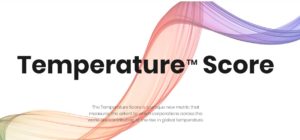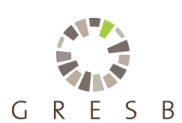
Over a third of the world’s 200 largest companies do not fully disclose their greenhouse gas (GHG) emissions, according to analysis from the Temperature™ Score, a new data tool launched today by Arabesque S-Ray that assesses how corporations worldwide report GHG emissions and contribute to global warming. The tool is the first of its kind that is based entirely on reported data, and identifies companies that have incomplete emissions reporting.
Covering 2,900 listed corporations – 76 percent of global market-cap – the Temperature Score translates publicly reported GHG emissions from each company to a Celsius degree temperature, based on sector-specific emissions pathways. The tool’s indicators reveal a lack of transparency and urgency from companies across all market sectors. Analysis from the Temperature Score shows that 52 of the world’s largest 200 companies by market cap do not fully disclose both Scope 1 emissions, accounting for the direct emissions from companies, and Scope 2 emissions, accounting for the indirect emissions from purchased electricity. 78 out of those 200 companies also do not report their Scope 3 emissions, which includes all other indirect emissions that occur in a company’s value chain.
The release of the score coincides with a new special report to be released tomorrow by the Intergovernmental Panel on Climate Change (IPCC), which warns that without urgent action, humanity faces unprecedented risks from fast-rising sea levels, threatening major coastal cities and the displacement of hundreds of millions of people.
Analysis from the Temperature Score shows that whilst just over half of companies (53%) covered have a near term score that aligns with the most ambitious Paris Agreement goal of keeping global temperature rise to 1.5°C, only a fifth of companies (20%) are expected to remain on this pathway by 2050 without taking drastic steps to reduce GHG output. Further analysis shows that almost a tenth (9 percent) of companies that support the Task Force on Climate-related Financial Disclosures (TCFD) – which seeks to develop recommendations for voluntary climate-related financial disclosures – do not fully report their emissions.
The Temperature Score is comprised of two parts: the main score and three key indicators. Scores are calculated using sector-specific climate pathways based on the International Energy Agency (IEA) scenarios and OECD GDP forecasts. The tool compares a company’s current emissions intensity to projected emissions intensities for 1.5°C, 2°C and 2.7°C scenarios of global temperature rise. Each company is given a near-term (2030) and a long-term (2050) score. Publicly reported company emissions are transformed to a temperature score of 1.5°C, 2°C, 2.7°C, >2.7°C. Where a company does not publicly report its emissions following the GHG Protocol and TCFD guidelines, it receives an incomplete disclosure score of 3°C. Three additional indicators are calculated to give further insight into the company’s level of climate action:
- Target – Does the company have a target with the Science Based Targets initiative to reduce GHG emissions to a level compatible with a 2°C scenario?
- Trend – Have the company’s recent emissions reductions followed the pathway that is required to reach net zero emissions and limit global temperature rise to 1.5°C?
- Scope 3 – Does the company report some part of its Scope 3 emissions?
Speaking on the launch of the new score, Christiana Figueres, former Executive Secretary of the UN Framework on Climate Change, said: “The Temperature Score is a very innovative methodology to measure the contribution that corporations are making towards temperature increase. We have a small but certain window of opportunity to make all the necessary efforts to keep the global temperature rise to 1.5 degrees Celsius, and thereby contribute to a safer, more productive, more socially inclusive and prosperous world.
As a transparency tool that will be helpful for investors, for corporates to compare each other, and for policy-makers, the Temperature Score has the potential to be a major force for change.”
Andreas Feiner, CEO of Arabesque S-Ray GmbH, said: “The key purpose for developing the Temperature Score is to increase transparency and accuracy around emissions reporting, highlighting those companies that are taking action towards limiting global temperature rise. Too many companies still do not publicly report their emissions, yet despite this, investors are still integrating climate scores into their investment decisions. How? By estimating emissions data using models.
This strategy prevents investors from accurately managing risk, as there is no way to differentiate between the companies that are reporting and taking the lead on climate action, and those that are not. Consequently, non-reporting, high emitting companies are not incentivized to report. Companies may appear to be taking steps to reduce their impact on climate change, but without public scrutiny of the data, this cannot be verified. Through the Temperature Score, we want to bring greater transparency to emissions reporting, and empower all stakeholders.”
Yolanda Kakabadse, former President of the World Wildlife Fund (WWF) International, said: “The climate crisis is not a problem that can be put off for a few years. It is here and now, as we can see with extreme events such as the increasing frequency of droughts and floods all over the world. As corporations are responsible for a significant proportion of GHG emissions, the private sector has a crucial role to play in helping to avoid the worst scenarios of global warming. Tools such as the Temperature Score are invaluable in shining more light on the leaders and laggards in emissions reporting, which will be to the benefit of all.”
For more information on the Temperature Score and for further data analytics, please visit www.arabesque.com/s-ray/temperature-score



